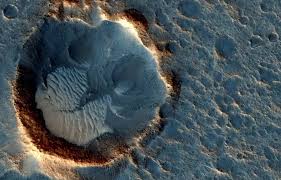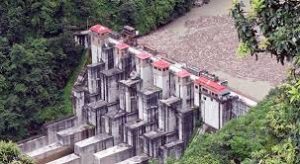Today’s Current Affairs: 22nd August 2024 for UPSC IAS exams, State PSC exams, SSC CGL, State SSC, RRB, Railways, Banking Exam & IBPS, etc
Table of Contents
Liquid Water On Mars:

A recent study has uncovered the presence of vast amounts of liquid water hidden deep within Mars’ rocky outer crust, marking a significant breakthrough in our understanding of the Red Planet.
- This discovery marks the first time that scientists have found evidence of liquid water on the Martian surface, beyond the known presence of water ice at the planet’s poles.
- The study, titled “Liquid water in the Martian mid-crust,” was published in the prestigious Proceedings of the National Academy of Sciences (PNAS).
- The research was conducted by a team of scientists from the University of California.
- The discovery could deepen our understanding of Mars’ water cycle, providing insights into the planet’s climatic history, surface processes, and internal structure.
- The presence of liquid water boosts the potential for finding habitable environments, enhancing the ongoing search for life on Mars.
- The researchers utilized data from NASA’s InSight Lander, which operated on the Martian surface from 2018 to 2022.
- The lander was equipped with a seismometer that recorded more than 1,300 Marsquakes and meteorite impacts over four years.
- By analysing the speed of the seismic waves, the researchers could infer the type of material the waves travelled through and apply a geophysical model to identify the presence of liquid water.
- The study identified a water-containing layer located at depths of 10 to 20 kilometres within the Martian crust.
- The water is believed to have seeped from the surface billions of years ago when Mars had a warmer climate and more permeable upper crust, similar to groundwater infiltration on Earth.
- If the findings are representative of the entire planet, the amount of water trapped in these rock fractures could fill an ocean 1-2 kilometres deep across Mars.
Ethanol Blending Program:

India is progressing towards its goal of 20% ethanol blending with petrol by 2025-26. However, concerns remain over the impact on food supplies and the fuel efficiency of existing vehicles.
- Ethanol is a biofuel produced through the fermentation of sugars by yeasts or via petrochemical processes such as ethylene hydration.
- It is rich in oxygen content, enabling more efficient fuel combustion in engines.
- Ethanol blending involves mixing ethanol derived from agricultural products with petrol to create a blended motor fuel.
Production of Ethanol in India: - The Department of Food and Public Distribution (DFPD) is the primary agency promoting the establishment of fuel-grade ethanol distilleries.
- Ethanol is produced from sugarcane-based materials like C & B heavy molasses, sugarcane juice, sugar syrup, surplus rice from the Food Corporation of India (FCI), and maize.
- Globally, over 110 billion litres of ethanol fuel were produced in 2019, with the US and Brazil contributing 84% of this production.
- India imports over 85% of its oil, and ethanol blending could reduce reliance on petroleum imports.
- In 2020-21, India’s net petroleum imports amounted to 185 million tonnes at USD 551 billion. Ethanol blending can save billions in foreign exchange.
- Ethanol is a less polluting fuel, offering similar efficiency to petrol at a lower cost.
Telecommunications Act And OTT:

The new Telecommunication Act has sparked debate over the definition of “telecommunication services.”Telecom operators and social media companies are at odds over whether over-the-top (OTT) platforms like WhatsApp and Google Meet are included in this definition.
- Telecommunications Act, 2023 Modernize and unify laws for the development, expansion, and operation of telecommunication services and networks.
- Address spectrum assignment and related matters.
- Supersedes the Indian Telegraph Act, 1885, and the Indian Wireless Telegraph Act, 1933, due to advancements in telecom technology.
- Promotes digital frameworks, including online dispute resolution.
- Guiding principles:
- Inclusion (Samavesh)
- Security (Suraksha)
- Growth (Vriddhi)
- Responsiveness (Tvarit)
- It reduces uncertainties and boosts investor confidence, aiding ease of doing business.
- Right of Way (RoW) framework: Applies to public and private properties, including government agencies, local bodies, and PPP projects like airports, seaports, and highways.
- Public entities must grant RoW permission promptly unless there are substantive grounds for refusal.
- Telecommunication infrastructure considered separate from the property it is on, reducing disputes during property transactions.
- Common ducts and cable corridors central Government to establish these in line with the PM Gati Shakti vision.
- Standards and conformity assessments sets standards for telecommunication services, networks, and security to ensure national security and promote Indian technology.
- Universal service obligation fund expanded to support services in underserved areas and fund R&D in telecom services and technologies.
Vaccine-Derived Polio:

A vaccine-derived polio case has been confirmed in a two-year-old child from Tikrikilla, Meghalaya. Health authorities clarified that this is not wild poliovirus but an infection seen in individuals with low immunity.
- India’s polio-free status: India was declared polio-free by the World Health Organization (WHO) in 2014, with the last wild poliovirus case reported in 2011.
- The Oral Polio Vaccine (OPV) contains a weakened form of the poliovirus, which stimulates an immune response.
cVDPV development: On rare occasions, in under-immunized populations, the excreted vaccine virus can circulate, undergo genetic changes, and potentially revert to a form capable of causing paralysis. - This is known as circulating vaccine-derived poliovirus (cVDPV).
- Since 2000, over 10 billion doses of OPV have been administered globally, resulting in 24 cVDPV outbreaks in 21 countries, with fewer than 760 cases.
- To stop cVDPV transmission, WHO recommends multiple rounds of high-quality immunisation campaigns.
Shaheen-II Missile:

The Pakistani military recently conducted the successful training launch of its surface-to-surface ballistic missile Shaheen-II.
- Shaheen-II Missile is a Pakistani medium-range surface-to-surface ballistic missile.
- It is believed that the Shaheen 2 is derived from the People’s Republic of China (PRC)-developed M-18, though this has not been confirmed.
- It is a solid-fueled, two-stage missile with an estimated range of 1,500–2,000 km.
- It measures 17.2 m long, 1.4 m in diameter, and weighs 23,600 kg at launch.
- It is designed to carry conventional or nuclear payloads.
- Its separating warhead is thought to feature four small motors to improve accuracy; the missile’s accuracy is estimated at 350 m circular error probable (CEP).
- It is transported and launched by a 6-axle transporter erector launcher (TEL).
- A ballistic missile is a rocket-propelled, self-guided strategic weapons system that follows a ballistic trajectory to deliver a payload from its launch site to a predetermined target.
- They are powered initially by a rocket or series of rockets in stages, but then follow an unpowered trajectory that arches upwards before descending to reach its intended target.
- They can carry conventional high explosives as well as chemical, biological, or nuclear munitions.
- They can be launched from aircraft, ships, and submarines, in addition to land-based silos and mobile platforms.
Slow Loris:

Villagers in Shimla Bagan, located in the Shantipur area on the Indo-Bhutan border in Chirang District, Assam, have reported the sighting of a rare species of the endangered primate Slow Lorris.
- Slow Loris found exclusively in South and Southeast Asia, slow lorises are the world’s only venomous primates.
- They’re arboreal—meaning they live in trees—and can be spotted curling up to sleep in branches or using vines and leaves to get around.
- They typically only come down to the forest floor when they need to defecate.
- There are nine species of slow loris. They all belong to the same genus, with each species sharing many similar characteristics and behaviours.
- The nine species include the Philippine slow loris, Bengal slow loris, greater slow loris, Kayan slow loris, Bangka slow loris, Bornean slow loris, Sumatran slow loris, Javan slow loris, and pygmy slow loris.
- Bengal slow loris (Nycticebus bengalensis) is listed as Endangered in the IUCN Red List. It is also legally protected under the Wildlife Protection Act, 1972.
- The range of the Bengal slow lorisextends from Vietnam to China, but in India, it is confined to India’s northeast.
Teesta-V Hydropower Station:

A landslide damaged six houses and a building of the National Hydroelectric Power Corporation (NHPC) at the site of its Teesta-V hydropower station in Sikkim’s Gangtok district recently.
- Teesta-V Hydropower Station is a 510 MW hydropower project located on the Teesta River basin in Gangtok district, Sikkim.
- This run-of-river project has an 88.6-meter high, 176.5-meter-long, concrete gravity dam impounding a regulating reservoir for daily power peaking.
- It has been developed in a single phase. The project construction commenced in 1999 and subsequently entered into commercial operation in 2008.
- The project is developed and owned bythe National Hydroelectric Power Corporation (NHPC).
- Teesta River is a trans-Himalayan River flowing through the Indian states of Sikkim and West Bengal and Rangpur in Bangladesh.
- It is a tributary of Brahmaputra river.
- This river forms a boundary between Sikkim and West Bengal.
HDFC Bank’s Sashidhar Jagdishan Highest Paid Bank CEO In FY23:
HDFC Bank’s Sashidhar Jagdishan Highest Paid Bank CEO In FY23 With Rs 10.55 Crore Pay Sashidhar Jagdishan, HDFC Bank’s
Managing Director and Chief Executive, has emerged as the highest-paid bank chief executive in FY23, with a significant increase of more than 62% in his remuneration in fiscal year 2023, reaching ₹10.55 crore, the PTI reported. Amitabh Chaudhry of Axis Bank was the second highest-paid bank CEO.
Mercury Bomb:

Recent study has found the potential environmental threat posed by melting Arctic permafrost, which could release significant amounts of mercury into the environment causing Mercury bomb.
- As the permafrost thaws due to climate change, mercury that has been trapped in the soil for millennia is being released, particularly along rivers like the Yukon in Alaska.
- While the immediate threat is minimal, the mercury could gradually accumulate in the food chain, posing long-term risks to human health, especially in Arctic communities.
- The study analyzed deeper soil layers in riverbanks and found consistent mercury levels with higher estimates from previous research.
LIC introduces new term assurance plan:“Jeevan Kiran”:
Life Insurance Corporation of India (LIC) introduced a new term assurance plan—Jeevan Kiran. LIC Jeevan Kiran is an individual, savings, and life Insurance plan. This plan is available for individuals from 18 years to 65 years, offers life cover with return of premium. It has a minimum sum assured of ₹15 lakh for moderate life cover.
Govind Mohan To Take Charge As Union Home Secretary:
Senior IAS officer Govind Mohan on August 22, will take charge as the new Union Home Secretary from Ajay Kumar Bhalla, who completes his five year tenure at the sensitive post, official sources said.
ICC Chairman:
The Board of Control for Cricket in India (BCCI) secretary Jay Shah is all set to replace the incumbent Greg Barclay as the new chairman of the International Cricket Council (ICC). His decision comes after being informed of Jay Shah’s intentions to replace him in November.
Ulchi Freedom Shield Exercises:
For the first time in recent history, the 51st Fighter Wing at Osan Air Base, Republic of Korea, is incorporating its recurring wing readiness exercise into Ulchi Freedom Shield 24. The 51st FW readiness exercise started on Aug.
Best Airport At The prestigious India Travel Awards:
The Rajiv Gandhi International Airport (RGIA) in Hyderabad has once again been recognized as the Best Airport at the prestigious India Travel Awards, marking its third consecutive win in this category. Consistent Excellence This latest accolade is a testament to RGIA’s unwavering commitment to delivering exceptional airport experiences for travelers.
Amul Tops Global Food Brand Rankings in 2024:
Amul has been named the world’s strongest food brand in Brand Finance’s Global Food & Drinks Report 2024. With a Brand Strength Index (BSI) score of 91 and a valuation of $3.3 billion, Amul achieved an 11% increase in brand value from 2023.




